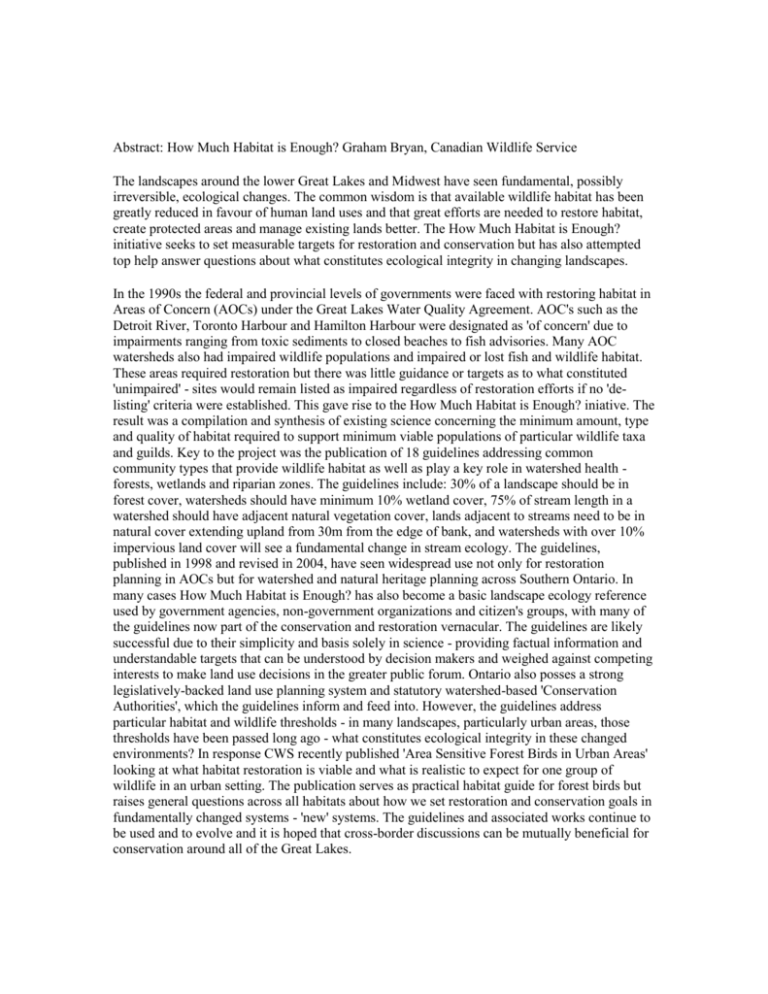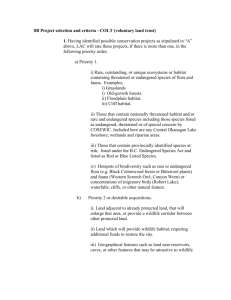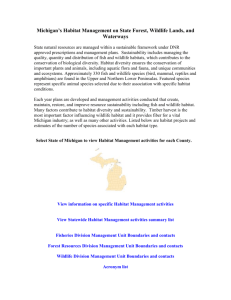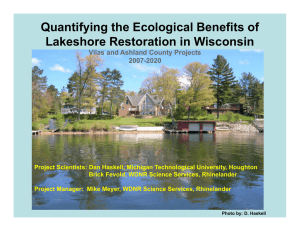Abstract: How Much Habitat is Enough
advertisement

Abstract: How Much Habitat is Enough? Graham Bryan, Canadian Wildlife Service The landscapes around the lower Great Lakes and Midwest have seen fundamental, possibly irreversible, ecological changes. The common wisdom is that available wildlife habitat has been greatly reduced in favour of human land uses and that great efforts are needed to restore habitat, create protected areas and manage existing lands better. The How Much Habitat is Enough? initiative seeks to set measurable targets for restoration and conservation but has also attempted top help answer questions about what constitutes ecological integrity in changing landscapes. In the 1990s the federal and provincial levels of governments were faced with restoring habitat in Areas of Concern (AOCs) under the Great Lakes Water Quality Agreement. AOC's such as the Detroit River, Toronto Harbour and Hamilton Harbour were designated as 'of concern' due to impairments ranging from toxic sediments to closed beaches to fish advisories. Many AOC watersheds also had impaired wildlife populations and impaired or lost fish and wildlife habitat. These areas required restoration but there was little guidance or targets as to what constituted 'unimpaired' - sites would remain listed as impaired regardless of restoration efforts if no 'delisting' criteria were established. This gave rise to the How Much Habitat is Enough? iniative. The result was a compilation and synthesis of existing science concerning the minimum amount, type and quality of habitat required to support minimum viable populations of particular wildlife taxa and guilds. Key to the project was the publication of 18 guidelines addressing common community types that provide wildlife habitat as well as play a key role in watershed health forests, wetlands and riparian zones. The guidelines include: 30% of a landscape should be in forest cover, watersheds should have minimum 10% wetland cover, 75% of stream length in a watershed should have adjacent natural vegetation cover, lands adjacent to streams need to be in natural cover extending upland from 30m from the edge of bank, and watersheds with over 10% impervious land cover will see a fundamental change in stream ecology. The guidelines, published in 1998 and revised in 2004, have seen widespread use not only for restoration planning in AOCs but for watershed and natural heritage planning across Southern Ontario. In many cases How Much Habitat is Enough? has also become a basic landscape ecology reference used by government agencies, non-government organizations and citizen's groups, with many of the guidelines now part of the conservation and restoration vernacular. The guidelines are likely successful due to their simplicity and basis solely in science - providing factual information and understandable targets that can be understood by decision makers and weighed against competing interests to make land use decisions in the greater public forum. Ontario also posses a strong legislatively-backed land use planning system and statutory watershed-based 'Conservation Authorities', which the guidelines inform and feed into. However, the guidelines address particular habitat and wildlife thresholds - in many landscapes, particularly urban areas, those thresholds have been passed long ago - what constitutes ecological integrity in these changed environments? In response CWS recently published 'Area Sensitive Forest Birds in Urban Areas' looking at what habitat restoration is viable and what is realistic to expect for one group of wildlife in an urban setting. The publication serves as practical habitat guide for forest birds but raises general questions across all habitats about how we set restoration and conservation goals in fundamentally changed systems - 'new' systems. The guidelines and associated works continue to be used and to evolve and it is hoped that cross-border discussions can be mutually beneficial for conservation around all of the Great Lakes.








